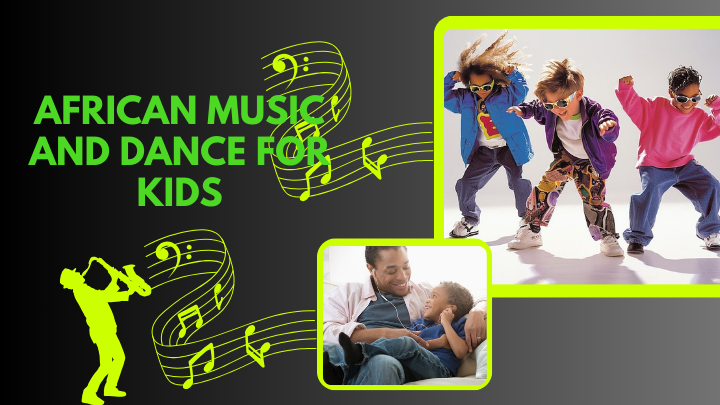African Music and Dance for Kids
African music and dance are not just forms of entertainment; they are vibrant expressions of culture, community, and history. With their infectious rhythms, energetic movements, and deep cultural significance, African music and dance provide a fun, engaging way for kids to stay active while learning about and celebrating their African heritage. Introducing children to African music and dance can be an exciting journey into the heart of African traditions, fostering creativity, physical activity, and a strong sense of cultural pride.
Here are some fun and interactive ways to introduce your kids to African music and dance, encouraging them to embrace movement, rhythm, and cultural connection.
1. Explore African Rhythms with Drumming
Drumming is a key part of African music, with different regions across the continent having their own unique rhythms and styles. The sound of African drums—whether the djembe, talking drum, or conga—is powerful and energetic, making it an ideal way to get kids moving and engaged.
How to Introduce Drumming:
- Use Simple Instruments: If you don’t have access to traditional African drums, you can create your own with household items. For example, use empty containers (like plastic buckets or tin cans) as makeshift drums. Even pots and wooden spoons can work as drumsticks, offering a great way to create rhythm without needing expensive equipment.
- Learn Basic Rhythms: Start by teaching kids a simple rhythm, clapping hands or tapping on the makeshift drums. Encourage them to follow the beats and explore variations, such as playing slower or faster or adding pauses for dramatic effect.
- Use Interactive Music: Play African drumming music or videos with drum beats for your kids to follow along. For example, there are countless tutorials online that break down popular African rhythms, which children can imitate.
- Get Creative with Group Drumming: If you have multiple children, create a mini drum circle where each child takes turns leading the rhythm, while the others follow. This encourages collaboration and listening skills, while reinforcing the idea of community, which is central to African culture.
Why It’s Fun: Drumming gets kids moving and grooving to infectious beats, while introducing them to the importance of rhythm in African music. It's an opportunity for children to make noise, express themselves, and experience the power of sound in a communal setting.
2. Learn African Dance Styles
African dance is known for its joyful, expressive movements, often characterized by energetic footwork, body isolations, and fluid arm motions. Dance plays an important role in African culture, with different regions having distinct styles and movements that tell stories or mark special occasions.
How to Introduce African Dance:
- Try Simple Dance Moves: Introduce your kids to easy-to-learn movements from African dance. For example, the "shuffling" dance move is common in many African styles. Start by showing your child how to shuffle their feet while keeping their body loose and fluid.
- Explore Dance Styles from Different Regions: African dance is diverse, with many different regional styles. For example, the energetic "Azonto" from Ghana or the graceful "Akan" dance from West Africa. Show your child videos of these dances and encourage them to try copying the moves. You can teach them to move their hips, shoulders, and arms to the music, emphasizing freedom of movement and expression.
- Incorporate African Music: Pair your dance lessons with traditional African music. When kids hear the rhythm and drums, their bodies will naturally want to move to the beat. Play music from different African countries and have your kids interpret the rhythms through movement.
- Use Dance to Tell a Story: Many African dances are connected to storytelling. Encourage your children to create their own dance performances based on African stories or folktales. This gives them a creative way to connect music, movement, and culture.
Why It’s Fun: African dance is high-energy and full of creativity, allowing children to express themselves physically while learning about cultural traditions. Dance also provides excellent exercise and helps develop coordination, rhythm, and flexibility.
3. Create a Family Dance Party: African Music Playlist
A great way to get your kids moving and celebrate African music is by hosting a family dance party with an African music playlist. This not only gets the kids up and active but also introduces them to the diverse sounds of African music, from Afrobeat to Highlife to traditional drumming rhythms.
How to Host a Family Dance Party:
- Create a Playlist of African Music: Compile a playlist that includes a mix of African genres, such as Afrobeat, Juju, Makossa, and traditional drumming music. Artists like Burna Boy, Angelique Kidjo, and Wizkid are great options for a lively dance atmosphere.
- Make It Interactive: Challenge your kids to dance to the beats, either imitating movements from African dances or simply creating their own free-flowing movements. You can also play games like "freeze dance," where they freeze when the music stops, or "follow the leader," where one person leads the dance and others copy their movements.
- Dress Up: Encourage everyone to dress in colorful clothes or even traditional African clothing. This adds an extra layer of fun and helps create a sense of celebration, even if it’s just at home.
Why It’s Fun: A family dance party is a fantastic way to bond while learning about African music and dance. It promotes movement, teamwork, and creativity, while celebrating African culture in a fun and lively way.
4. Craft Instruments to Play Along
Creating simple African-inspired instruments at home is a fantastic way to further engage your children with African music. Homemade instruments give kids a hands-on way to learn about the sounds of Africa while incorporating craft activities into the process.
How to Make Simple African Instruments:
- Make a Balafon (Wooden Xylophone): Use wooden dowels, empty cans, or pieces of scrap wood to create a simple balafon, which is a type of wooden xylophone popular in West Africa. Arrange the pieces of wood to create different tones and use spoons or sticks to tap on them.
- Create a Shekere (Gourd Shaker): Use a large plastic bottle and fill it with beads, rice, or small pebbles. Decorate it with colorful ribbons or fabric, and then use it as a shaker. This instrument is commonly used in African music for adding rhythm.
- Design a Ngoma Drum: You can use empty containers or cardboard tubes to make small ngoma drums, a type of drum found in Central Africa. Cover the top with fabric or a balloon for a tight surface, and secure it with tape. Kids can decorate their drums with paint or stickers.
Why It’s Fun: Crafting instruments before playing them adds a tactile dimension to the music experience. Kids will love creating their own instruments and will feel a deeper connection to African music as they play along to the rhythms.
5. Sing African Songs and Rhymes
African songs are often passed down through generations, and they are a great way to introduce children to the sounds and languages of Africa. Many of these songs have catchy rhythms and simple lyrics that children can easily pick up, making it a perfect activity for young ones.
How to Sing African Songs:
- Learn Simple African Songs: Teach your children traditional African songs, such as "Mbube" (also known as "The Lion Sleeps Tonight") or "Jambo Bwana," a popular Swahili greeting song. These songs are fun to sing and have repetitive, easy-to-learn lyrics.
- Use Hand Movements: Many African songs involve hand claps, stomping, or finger snapping, which adds a rhythmic element to the singing. Teach your children to incorporate these movements into the song to enhance the experience.
- Explore Songs in Different Languages: If you're familiar with any African languages, teach your kids songs in languages such as Swahili, Yoruba, or Zulu. This not only introduces them to the linguistic diversity of Africa but also deepens their cultural understanding.
Why It’s Fun: Singing African songs is a joyful and interactive way to connect with culture. It enhances language skills, rhythm, and memory, all while fostering an appreciation for African music traditions.
African music and dance offer a lively, exciting way to celebrate culture, stay active, and bond as a family. Whether through drumming, dancing, creating instruments, or singing, these activities bring the rhythms and spirit of Africa into your home, encouraging children to connect with their heritage in a fun and engaging way. Through music and movement, kids not only learn about African culture but also develop creativity, coordination, and confidence. So, turn up the music, get moving, and celebrate the beauty of African traditions with your family!



